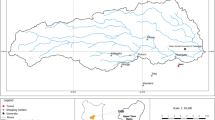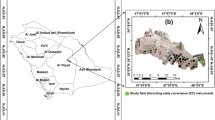Abstract
This study evaluated SWAT model when measured Evapotranspiration (ET) and Soil Moisture (SM) in addition to streamflow (Q) data were used to calibrate the simulated values in a 8.54 km2 hillslope watershed of South Korea. By using 7 years (2003–2009) daily Q at the watershed outlet, 3 years (2007–2009) daily ET and SM data measured in the mixed forest, the SWAT model was calibrated and validated with the average Nash-Sutcliffe model efficiency (E) for Q of 0.76, and the coefficient of determination (R2) for SM and ET of 0.55 and 0.59, respectively. The use of measured hydrological state variables such as ET or SM in SWAT modeling provided more reliable interpretation of model parameters by inducing the reduction of parameter uncertainty and understanding the behavior of the watershed water balance. When the watershed has only Q data for model calibration, it is encouraged to consider soil (ESCO) and plant related parameters (EPCO and CANMX) in addition to surface runoff (CN2, and Surlag) and groundwater related parameters (GW_ DELAY and GW_ REVAP).
Similar content being viewed by others
References
Ambroise, B., Perrin, J. L., and Reutenauer, D. (1995). “Multicriterion validations of a semidistributed conceptual model of the water cycle in the Fecht catchment (Vosges, Massif. France).” Water Resources Research, Vol. 31, No. 6, pp. 1467–1481.
Arnold, J. G. and Allen, P. M. (1996). “Estimating hydrologic budgets for three illinois watersheds.” Journal of Hydrology, Vol. 176, No. 1, pp. 57–77.
Bastidas, L. A., Gupta, H., Hsu, VK-l., and Sorooshian, S. (2003). “Parameter, structure, and model performance evaluation for land-surface schemes.” Calibration of Watershed Models, Water Science and Applications, Duan, Q., Sorooshian, S., Gupta, H., Rosseau, H., and Turcotte, R. (Eds.), Vol. 6, pp. 239–254.
Cao, W., Bowden, W. B., Davie, T., and Fenermor, A. (2006). “Multivariable and multi-site calibration and validation of SWAT in a large mountainous catchment with high spatial variability.” Hydrological Processes, Vol. 20, No. 5, pp. 1057–1073.
Galvan, L., Olias, M., Fernandez de Villaran, R., Domingo Santos, J. M., Nieto, J. M., Sarmiento, A. M., and Canovas, C. R. (2009). “Application of the SWAT model to an AMD-affected river (Meca River, SW Spain) Estimation of transported pollutant load.” Journal of Hydrology, Vol. 377, Nos. 3–4, pp. 445–454.
Gassman, P. W., Reyes, M. R., Green, C. H., and Arnold, J. G. (2007). “The soil and water assessment tool: Historical development, applications, and future research directions.” American Society of Agricultural and Biological Engineers, Vol. 50, No. 4, pp. 1211–1250.
Green, C. H., Tomer, M. D., Di Luzio, M., and Arnold, J. G. (2006). “Hydrologic evaluation of the Soil and Water Assessment Tool for a large tile-drained watershed in Iowa.” American Society of Agricultural and Biological Engineers, Vol. 49, No. 2, pp. 413–422.
Hydrological Survey Center of Korea. (2007). “Measurement of soil moisture.” Report of Hydrological Survey, pp. 55–59.
Jakeman, A. J. and Hornberger, G. M. (1993). “How much complexity is warranted in rainfall-runoff model.” Water Resources Research, Vol. 29, No. 8, pp. 2637–2649.
Joh, H. K., Lee, J. W., Park, M. J., Shin, H. J., Yi, J. E., Kim, G. S., Srinivasan, R., and Kim, S. J. (2011). “Assessing climate change impact on hydrological components of a small forest watershed through SWAT calibration of evaportranspiration and soil moisture.” Transactions of the ASABE, Vol. 54, No. 5, pp. 1773–1781.
Kannan, N., White, S. M., Worrall, F., and Whelan, M. J. (2007). “Sensitivity analysis and identification of the best evapotranspiration and runoff options for hydrological modeling in SWAT-2000.” Journal of Hydrology, Vol. 332, Nos. 3–4, pp. 456–466.
Kuczera, G. and Mroczkowski, M. (1998). “Assessment of hydrological parameter uncertainty and the worth of multi-response data.” Water Resources Research, Vol. 34, No. 6, pp. 1481–1489.
Kwon, H. J., Lee, J. H., Lee, Y. K., Lee, J. W., Jung, S. W., and Kim, J. (2009). “Seasonal variations of evapotranspiration observed in a mixed forest in the seolmacheon catchment.” Korean Journal of Agricultural and Forest Meteorology, Vol. 11, No. 1, pp. 39–47.
Legates, D. R. and McCabe, G. J. (1999). “Evaluating the use of goodness-of-fit measures in hydrologic and model validation.” Water Resources Research, Vol. 35, No. 1, pp. 233–241.
Manguerra, H. B. and Engel, B. A. (1998). “Hydrologic parameterization of watersheds for runoff prediction using SWAT.” Journal of the American Resources Association, Vol. 34, No. 5, pp. 1149–1162.
Mapfumo, E., Chanasyk, D. S., and Willms, W. D. (2004). “Simulating daily soil water under foothills fescue grazing with the Soil and Water Assessment Tool model (Alberta, Canada).” Hydrological Processes, Vol. 18, No. 3, pp. 2787–2800.
Massman, W. J. (2000). “A simple method for estimating frequency response corrections for eddy covariance systems.” Agricultural and Forest Meteorology, Vol. 104, No. 3, pp. 185–198.
McKay, M. D. (1988). “Sensitivity and uncertainty analysis using a statistical sample of input values.” Uncertainty Analysis, Ronen, Y. (Ed.), CRC Press Inc., Boca Raton, Florida, pp. 145–186.
Muleta, M. K. and Nicklow, J. W. (2005). “Sensitivity and uncertainty analysis coupled with automatic calibration for a distributed watershed model.” Journal of Hydrology, Vol. 306, Nos. 1–4, pp. 127–145.
Nash, J. E. and Sutcliffe J. V. (1970). “River flow forecasting through conceptual models: Part I. A discussion of principles.” Journal of Hydrology, Vol. 10, No. 3, pp. 283–290.
Neitsch, S. L., Arnold, J. G., Kiniry, J. R., Srinivasan, R., and Williams, J. R. (2002). Soil and water assessment tool: User’s manual: Version 2000, Temple, Texas: USDA-ARS GSWRL and Blackland Research Center, Texas Agricultural Experiment Station.
Neitsch, S. L., Arnold, J. G., Kiniry, J. R., Srinivasan, R., and Williams, J. R. (2004). Soil and water assessment tool input/output file documentation version 2004: Draft-September 2005, Temple, Texais USA: Grassland, Soil and Water Research Laboratory, Agricultural Research Service, Blackland Research Center, Texas Agricultural Experiment Station.
Peterson, J. R. and Hamlett, J. M. (1998). “Hydrologic calibration of the SWAT model in a watershed containing fragipan soils.” Journal of the American Water Resources Association, Vol. 34, No. 3, pp. 531–544.
Qi, C. and Grunwald, S. (2005). “GIS-based hydrologic modeling in the Sandusky watershed using SWAT.” Transaction of American Society of Agricultural and Biological Engineers, Vol. 48, No. 1, pp. 169–180.
Refsgaard, J. C. (1997). “Parameterization, calibration and validation of distributed hydrologic models.” Journal of Hydrology, Vol. 198, No. 1–4, pp. 69–97.
Saltelli, A., Chan, K., and Scott, E. M. (2000). Sensitivity analysis, Wiley, New York.
Santhi, C., Arnold, J. G., Williams, J. R., Dugas, W. A., Srinivasan, R., and Hauck, L. M. (2001a). “Validation of the SWAT model on a large river basin with point and nonpoint sources.” Journal of the American Water Resources Association, Vol. 37, No. 5, pp. 1169–1188.
Seibert, J. and McDonnell, J. J. (2003). “The quest for an improved dialog between modeler and experimentalist.” Calibration of Watershed Models, Water Science and Applications, Duan, Q., Sorooshian, S., Gupta, H., Rosseau, H., and Turcotte, R. (Eds.), Vol. 6, pp. 301–316.
Soil Moisture Equipment Corp. (2003). Trase operation instructions, Soil Moisture Equipment Corp.
Sophocleous, M. A., Koelliker, J. K., Govindaraju, R. S., Birdie, T., Ramireddygari, S. R., and Perkins, S. P. (1999). “Integrated numerical modeling for basin-wide water management: The case of the rattlesnake creek basin in south-central kansas.” Journal of Hydrology, Vol. 214, No. 1, pp. 179–196.
Ullrich, A. and Volk, M. (2009). “Application of the Soil and Water Assessment Tool (SWAT) to predict the impact of alternative management practices on water quality and quantity.” Agricultural Water Management, Vol. 96, No. 8, pp. 1207–1217.
Van Griensven, A. and Meixner, T. (2003). “Sensitivity, optimization and uncertainty analysis for the model parameters of SWAT.” In: SWAT2003: 2nd International SWAT Conference, Bari, Italy, 1–4 July.
Vazquez-Amabile, G. G., and Engel, B. A. (2005). “Use of SWAT to compute groundwater table depth and streamflow in the Muscatatuck River watershed.” Transaction of the American Society of Agricultural and Biological Engineers, Vol. 48, No. 3, pp. 991–1003.
White, K. L. and Chaubey, I. (2005). “Sensitivity analysis, calibration, and validations for a multisite and multivariable SWAT model.” Journal of the American Water Resources Association, Vol. 41, No. 5, pp. 1077–1089.
Zhang, X., Srinivasan, R., and Hao, F. (2007). “Predicting hydrologic response to climate change in the luohe river basin using the SWAT model.” American Society of Agricultural and Biological Engineers, Vol. 50, No. 3, pp. 901–910.
Author information
Authors and Affiliations
Corresponding author
Rights and permissions
About this article
Cite this article
Park, G.A., Park, J.Y., Joh, H.K. et al. Evaluation of mixed forest evapotranspiration and soil moisture using measured and swat simulated results in a hillslope watershed. KSCE J Civ Eng 18, 315–322 (2014). https://doi.org/10.1007/s12205-014-0193-z
Received:
Revised:
Accepted:
Published:
Issue Date:
DOI: https://doi.org/10.1007/s12205-014-0193-z




